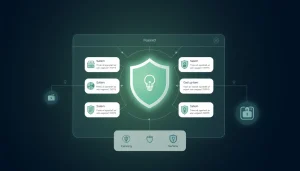Mastering Competitive Intelligence: Strategies and Best Practices for Business Success
1. Understanding Competitive Intelligence
In today’s rapidly evolving business landscape, understanding the competitive environment is crucial for success. Competitive intelligence (CI) serves as a strategic tool that organizations can leverage to gain insights into their competitors and the market dynamics. By compiling essential data, assessing consumer behavior, and evaluating industry trends, businesses can harness CI to create a robust strategy, thereby enhancing their market position while pushing for innovation.
1.1 Definition and Importance
Competitive intelligence refers to the systematic process of gathering, analyzing, and disseminating data regarding the competitive landscape. This includes insights about competitors’ products, strategies, market positioning, and consumer preferences. The importance of CI can be highlighted through its roles in:
- Strategic Decision-Making: CI supports organizational leaders in making informed decisions rooted in external realities rather than assumptions.
- Market Predictions: By monitoring competitor movements and market changes, businesses can better anticipate and adjust to future trends.
- Operational Efficiency: CI can reveal inefficiencies in both competitors’ practices and one’s own processes, paving the way for improvements.
1.2 Key Components of Competitive Intelligence
The framework of CI consists of several essential components that must be understood and implemented effectively:
- Data Collection: The process of gathering relevant information through various channels such as industry reports, news articles, social media, and public records.
- Analysis: Evaluating the gathered data to extract valuable insights. This often involves identifying patterns, forecasting trends, and recognizing competitive threats.
- Dissemination: Sharing insights among key stakeholders in the organization to ensure all relevant personnel are informed and ready to act based on data-driven decisions.
1.3 Common Misconceptions about Competitive Intelligence
Despite its proven value, CI is often misunderstood. Here are a few prevalent misconceptions:
- CI is Espionage: Many believe that CI involves unethical practices akin to corporate spying. In reality, ethical CI is about gathering publicly available information and respecting legal boundaries.
- CI is Only for Large Companies: Smaller businesses can benefit just as much from CI to identify niche opportunities and areas for improvement.
- CI is a One-Time Activity: Competitive intelligence should be an ongoing process due to the dynamic nature of markets and competitors.
2. Types of Competitive Intelligence
Understanding the different types of competitive intelligence is critical for a comprehensive approach to gathering data. Each type serves a unique purpose and captures various facets of market dynamics.
2.1 Market Intelligence
Market intelligence focuses on the macro-level environment, including trends, consumer preferences, and broader industry shifts. It can help businesses:
- Anticipate changes in demand and adjust their strategies accordingly.
- Identify new market opportunities or threats.
- Benchmark their performance against industry standards.
For instance, during the COVID-19 pandemic, many businesses utilized market intelligence to pivot their strategies in response to changing consumer behavior.
2.2 Product Intelligence
This form of intelligence zeroes in on competitors’ product offerings, pricing strategies, and customer satisfaction levels. It provides insights that allow a business to:
- Enhance their products based on user feedback and competitive offerings.
- Adjust pricing strategies in response to competitor actions.
- Identify gaps in the market that can be exploited.
For example, a tech firm might analyze competitor features and customer reviews to refine their own product’s design and functionalities.
2.3 Customer Intelligence
Customer intelligence delves into the behaviors, needs, and preferences of the target market. It includes:
- Analyzing customer feedback and reviews.
- Segmentation studies to understand different consumer personas.
- Tracking customer journey and interaction with the brand.
Effective customer intelligence allows for personalized marketing strategies that resonate more profoundly with specific audiences, leading to increased brand loyalty and conversion rates.
3. Gathering Competitive Intelligence Data
The success of competitive intelligence efforts hinges on the ability to collect data effectively. Here are the primary methods and tools involved in this process.
3.1 Data Collection Methods
There are several established methods for collecting competitive intelligence data, predominantly falling into two categories: primary and secondary research.
- Primary Research: This involves gathering data firsthand through surveys, interviews, and focus groups. Businesses can tailor their questions to extract specific information relevant to their CI needs.
- Secondary Research: Refers to collecting data that has already been published, such as market reports, academic journals, and news articles. This method is often less time-consuming and provides a wealth of information.
3.2 Tools for Competitive Intelligence
Various tools can facilitate the collection and analysis of competitive intelligence data, including:
- Google Alerts: This tool allows users to monitor online discussions and find new content on specific topics or competitors.
- SEMrush: A powerful tool for analyzing competitors’ online strategies including SEO, PPC, and keyword research.
- SpyFu: Offers insights into competitors’ search marketing strategies, revealing keywords they target and their ad performance.
Choosing the right tools depends on specific business needs, budgets, and the types of intelligence required.
3.3 Ethical Considerations in Data Gathering
It’s essential to adhere to ethical guidelines while gathering competitive intelligence. Key considerations include:
- Ensuring data is gathered from legitimate and public sources.
- Avoiding misleading or deceptive practices in the collection process.
- Respecting IP rights and confidentiality agreements.
Failing to observe ethical practices can result in legal repercussions and damage to the organization’s reputation.
4. Analyzing and Utilizing Competitive Intelligence
Once you have gathered competitive intelligence data, the next challenge is effective analysis and utilization. Understanding how to translate raw data into actionable insights is crucial for strategic planning.
4.1 Turning Data into Actionable Insights
The transformation of data into actionable insights involves several steps:
- Data Cleaning: Ensure that the collected data is accurate, complete, and relevant.
- Data Analysis: Use analytical tools and techniques to identify trends, correlations, and anomalies within the data.
- Insight Generation: Synthesize findings into clear insights that provide strategic recommendations.
For instance, a retail company might analyze customer buying patterns to predict peak sales periods and optimize inventory accordingly.
4.2 Best Practices for Competitive Analysis
Adhering to best practices can significantly improve the outcomes of competitive analysis:
- Continuous Monitoring: Regularly update the intelligence database with new insights to keep strategies relevant.
- Collaborative Analysis: Involve cross-functional teams in compiling and evaluating CI data to gain diverse perspectives.
- Scenario Planning: Create multiple scenarios based on competitor actions to prepare for potential market shifts.
4.3 Case Studies: Successful Implementation
Many successful companies have effectively harnessed the power of competitive intelligence. A classic example includes:
Netflix: With its innovative algorithm, Netflix analyzes viewing habits to not only customize viewer recommendations but also to inform content production decisions. By understanding what types of shows are popular, Netflix has successfully tailored its programming, leading to increased subscriber retention and satisfaction.
5. Measuring the Impact of Competitive Intelligence
It is vital to assess the effectiveness of competitive intelligence initiatives regularly. This ensures that insights are leading to real improvement and aligns with business goals.
5.1 Key Performance Indicators (KPIs)
The measurement of CI impact includes identifying relevant KPIs, such as:
- Market Share: Changes in market share can indicate the success of competitive strategies.
- Sales Growth: Increases in sales following CI implementation suggest that insights have positively influenced business decisions.
- Customer Satisfaction: More extensive customer feedback analysis can demonstrate the effectiveness of tailored service or product offerings.
5.2 Tools for Performance Measurement
Employing the right tools can help in tracking the aforementioned KPIs:
- Dashboard Software: Tools like Tableau or Google Data Studio can help visualize data and performance metrics in real-time.
- CRM Systems: Integrated CRM systems like Salesforce can track customer interactions and satisfaction, correlating these metrics with CI insights.
5.3 Adjusting Strategy Based on Insights
Continuous improvement is essential in a competitive environment. Businesses must remain agile and ready to adjust their strategies based on insights gained through CI, fostering a culture of adaptability.
This might involve re-evaluating product lines, altering marketing approaches, or even re-structuring teams to better align with consumer needs and competitor tactics.














Post Comment